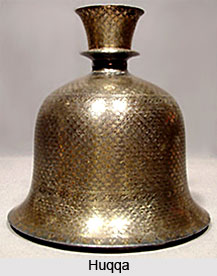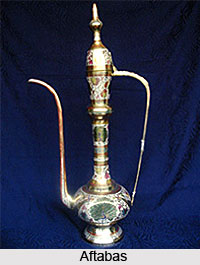 Indian Sliver Ware dates before the nineteenth century. Silver Art in Mughal Empire includes various types of silver ware that are found in the country are pandans, huqqas, aftabas, lotas and a lot more. A hammered silver-gilt rose water sprinkler is an important silver work under the Mughal dynasty. The piece was from the eighteenth or even a nineteenth-century. The sprinkler has multitude of animals including monkeys, foxes and deer - engraved in lively poses resemble those on Persian metal bowls. The blossoms surrounding these figures are similar to the Chinese-derived ornament on contemporary Indian painted cottons (palampores or kalamkaris), and the projecting volumes on foot and neck also have a Far Eastern feel.
Indian Sliver Ware dates before the nineteenth century. Silver Art in Mughal Empire includes various types of silver ware that are found in the country are pandans, huqqas, aftabas, lotas and a lot more. A hammered silver-gilt rose water sprinkler is an important silver work under the Mughal dynasty. The piece was from the eighteenth or even a nineteenth-century. The sprinkler has multitude of animals including monkeys, foxes and deer - engraved in lively poses resemble those on Persian metal bowls. The blossoms surrounding these figures are similar to the Chinese-derived ornament on contemporary Indian painted cottons (palampores or kalamkaris), and the projecting volumes on foot and neck also have a Far Eastern feel.
A finer gulabpash of the same type has an open-work pedestal supporting a bulbous water chamber, a tapering neck, a pierced moveable ring and a very tall spire, the whole surprisingly majestic for so small and light an object. The belly is decorated with fine floral scrollwork, again with a Chinese air, inhabited by vigorously observed squirrels, curiously reminiscent of those in the great Mughal painting. A large repose flask has been assigned to the eighteenth century. In the flask animals in violent movement against a ring-punched ground are found.
Tiny silver pandan bears repose ornament of various flowers alternating with cypress trees. This is a border scheme common to the imperial Mughal vocabulary which was applied to both architecture and the decorative arts, especially textiles. The shape has a fully proportioned Timurid-style dome, from the apex of which radiates an exquisite "fishscale" pattern, akin to the full-blown lotus.
 A small silver flask for antimony only 8.9 cm high is a remarkable translation into silver of the properties of seventeenth-century Mughal columns. It has a cusped melon shape and stylised acanthus designs. Two small hammered trays are also important works of silver during the Mughal Era. The smaller of the two has concentric bands of floral and vegetal ornament around a central twelve pointed star. The larger has a raised centre, a field of cypresses alternating with flowering trees in low relief, then a band of depressed ovals, familiar from both Byzantine and classical silver trays, and finally open-work scrollwork of unusual fluidity. Both pieces retrain traces of gilding.
A small silver flask for antimony only 8.9 cm high is a remarkable translation into silver of the properties of seventeenth-century Mughal columns. It has a cusped melon shape and stylised acanthus designs. Two small hammered trays are also important works of silver during the Mughal Era. The smaller of the two has concentric bands of floral and vegetal ornament around a central twelve pointed star. The larger has a raised centre, a field of cypresses alternating with flowering trees in low relief, then a band of depressed ovals, familiar from both Byzantine and classical silver trays, and finally open-work scrollwork of unusual fluidity. Both pieces retrain traces of gilding.
A gulabpash with the lush curves of the Mughal baluster pillar can be placed in the eighteenth century. A silver-gilt open-work shell composed of finely worked flowers and acanthus leaves fits snugly over a silver core, the two colours - grey and gold - contrasting smartly. Its most remarkable features are the peacock and peahen perched upon opposite shoulders of the water chamber, their necks straining gracefully back to preen their feathers. Their astonishing realism, and the extra little leaf placed beneath the peahen to compensate for her shorter tail, detracts in no way from this triumph of harmonious abstraction.
An equally well-proportioned silver bottle dating in the 17th century is also part of the Silver Art in the Mughal era. In the silver bottle instead of the feminine fluidity and relative realism of the latter`s applied ornament there is an austere architectural aesthetic. An open-work parcel gilt silver scabbard is also from the eighteenth century. Its intricate scrollwork is based mainly on the Mughal iris; its acanthus leaves on the top and along the edge, and the distinctive swirled hollows on petals and leaves all have parallels with plate. On one side the arabesque is purely floral, while on the other tiny birds hop in and out of tendrils, all cast with masterful precision.
Pierced surfaces are the main decorative element of several parcel gilt pieces, some of cast open-work, others of a kind of wire work, still others of filigree. The walls, roof and unusually small dome of a cast twelve-lobed pandan have that amalgam of rigorous geometry and fine floral open-work common to Mughal jalis. Its quatrefoil blossoms betray a Deccani origin and are very similar to those on a slightly earlier round brass incense burner. An octagonal pandan with a gabled roof is also of cast pierced silver, with writhing flowering plants as its chief motif. This, and its handle of makaras (mythological marine monsters), suggest a Rajasthani or Gujrati origin.
An extremely rare technique, possibly of Chinese origin, exploited the decorative potential of twisted silver wire placed like a net over a silver core. A circular domed pandan combines this procedure with appliqu‚ strips of hammered silver engraved to resemble cypress trees. Inside the domed cover, a floral trellis pattern of tremendous vigour, against a ring-punched ground, excludes - on stylistic grounds - the possibility of a date later than the first half of the eighteenth century. At Karimnagar in the Deccan more masterfully worked wire was used in the silver filigree objects.



















